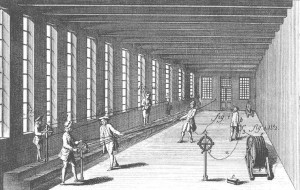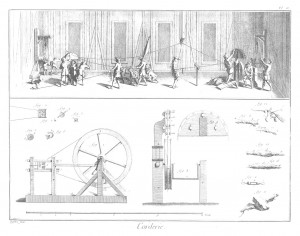Cord had many uses in clothing-making, including being stitched under fabric to add texture and patterns, and being used to lace stomachers. Stomachers were the front panels of women’s bodices that helped form the V-shape desired of the body. They were worn between the sixteenth- and eighteenth-centuries. Stomachers were sometimes threaded with ribbon or braids in place of cords, or embroidered, quilted, or decorated with lace. The passementerie technique was used for the threading of cord, buttons, braids, tassels, and other decorations into fabric. Cord could be used to create both bold textures and delicate floral patterns.
In the process of making cord, thread was unwound from a large spool (on the right in the Encyclopédie plate above), looped through a pulley, and then outstretched by a worker. Holding the string, this worker would walk the required distance, depending on the desired length of the cord. A second thread, attached to a gear wheel, would then be stretched to the same length. A second worker would intertwine the strings by hang-cranking a spinning wheel to complete the cord (on the left). The plate below shows details of the spinning wheel.
For more information on cord, please see:
Diderot, Denis, and Jean Le Rond d’Alembert. Encyclopédie Ou Dictionnaire Raisonné Des Sciences, Des Arts et Des Métiers. Geneve: J.L. Pellet; [etc.], 1778.
Hart, Avril, and Susan North. Seventeeh and Eighteenth-Century Fashion in Detail. London: V&A Publishing, 1998.
Image citations:
Diderot, Denis, and Jean Le Rond d’Alembert. Encyclopédie Ou Dictionnaire Raisonné Des Sciences, Des Arts et Des Métiers. Geneve: J.L. Pellet; [etc.], 1778.
Hart, Avril, and Susan North. Seventeeh and Eighteenth-Century Fashion in Detail. London: V&A Publishing, 1998.



